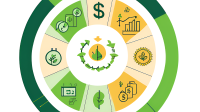Circular economy technology is transforming how businesses operate and creating sustainable value across industries. From AI-powered recycling to blockchain-enabled supply chains, these innovations are driving a $1 trillion market opportunity while dramatically reducing environmental impact. This comprehensive guide explores the latest technological advances revolutionizing circular economy practices.

The Future of Sustainable Business is Circular
The world is rapidly changing, and at the heart of this transformation lies an innovative approach to how we use and reuse our resources. Circular economy technology isn’t just another buzzword – it’s revolutionizing how businesses operate, with the World Economic Forum projecting $1 trillion in annual material cost savings potential.
Key Transformation Metrics

- $1 trillion annual material savings potential
- 45% reduction in global emissions possible
- 3x improvement in resource productivity
- 80% of executives investing in circular tech
These impressive metrics tell a compelling story of transformation. With 80% of executives now investing in circular technology solutions and companies achieving up to three times improvement in resource productivity, the shift towards circular economy isn’t just environmental – it’s a business imperative. Think about your smartphone for a moment. Every year, millions of phones end up in landfills, taking valuable resources with them. But what if technology could help us break this wasteful cycle? That’s exactly what’s happening across industries today, and the results are remarkable.
The Digital Revolution in Circular Economy
AI & Machine Learning Transformation
The landscape of waste management has evolved dramatically through AI innovation. Smart sorting systems in Barcelona now achieve 95% accuracy, revolutionizing material processing. Advanced machine learning algorithms enable real-time waste classification, reducing sorting errors by 40% while increasing processing speed five-fold. Leading companies like TerraCycle are using AI-powered optical sorting to identify and separate materials at the molecular level, achieving unprecedented recycling precision.
IoT Integration & Impact
IoT sensors are transforming product lifecycle management and maintenance prediction. Michelin’s EFFIFUEL™ program exemplifies this evolution, using IoT sensors to:
- Reduce fuel consumption by 2.5L/100km
- Extend tire lifespan by 20%
- Decrease maintenance costs by 30%
Real-world applications show IoT networks improving resource tracking accuracy by 85% and reducing waste by identifying reuse opportunities before materials enter the waste stream.
Blockchain Solutions
Blockchain technology provides unprecedented supply chain transparency and material traceability. IBM’s Food Trust network demonstrates the power of this approach:
- 20% reduction in food waste
- 80% improvement in supply chain traceability
- 40% decrease in verification time
This technology enables companies to track materials from source to recycling, ensuring authentic circular practices and building consumer trust through verifiable sustainability claims.
Impact of Digital Technologies:
- AI: 95% sorting accuracy
- IoT: 30% waste reduction
- Blockchain: 80% improved traceability
Implementation & Business Benefits
The numbers tell a compelling story. According to the Ellen MacArthur Foundation, companies implementing circular technologies are seeing up to three times improvement in resource productivity. But what does this mean in practice?
Consider Philips Healthcare’s journey. By reimagining their business model through circular principles, they’ve increased revenue by 25% from refurbished equipment alone. Their success isn’t an isolated case – Interface achieved a 58% reduction in carbon footprint while improving their bottom line, and IKEA has generated €3.5 billion in circular product sales.
Implementation Success Stories
Enterprise Case Studies
The tech giants are leading the way in circular innovation with remarkable results. Apple’s groundbreaking “Daisy” robot showcases the pinnacle of automated recycling technology – methodically dismantling 200 devices every hour with surgical precision to recover valuable materials that would otherwise be lost to landfills. This isn’t just recycling; it’s pioneering a new era of resource recovery.
Philips Healthcare has revolutionized their business model through circular principles, achieving a stunning 25% revenue increase from refurbished medical equipment. This success demonstrates how sustainability and profitability can work hand in hand, creating a win-win situation for both business and environment.
Learn more about Philips circular economy practices.
Meanwhile, IBM’s Food Trust network has transformed food supply chain management, using blockchain technology to slash food waste by 20%. Their system provides unprecedented transparency, allowing businesses to track products from farm to table while significantly reducing waste throughout the journey.
Implementation Impact Data
| Company | Technology | Results |
|---|---|---|
| Philips Healthcare | Refurbishment Tech | 25% Revenue Increase |
| Apple | Daisy Robot | 200 devices/hour |
| IBM Food Trust | Blockchain | 20% Waste Reduction |
| Barcelona City | Smart Waste System | 40% Cost Reduction |
SME Applications
The circular economy isn’t just for large corporations – smaller enterprises and cities are achieving equally impressive results. Barcelona’s smart waste management system stands as a shining example, slashing collection costs by 40% through innovative technology implementation. Their success has created a blueprint for cities worldwide.
Amsterdam’s commitment to circular principles has yielded extraordinary results in waste sorting, achieving a remarkable 50% improvement in efficiency. This transformation wasn’t achieved overnight – it required careful planning, community engagement, and strategic technology deployment.
Singapore’s story adds another dimension to urban sustainability. By implementing smart technologies across their infrastructure, they’ve achieved 30% energy savings citywide. This comprehensive approach shows how integrated technology solutions can transform entire urban ecosystems.
Through these success stories, we see how organizations of all sizes are turning circular economy principles from theory into profitable reality. Each case demonstrates that with the right technology and commitment, sustainable practices can deliver substantial business value.
The Road to Implementation
Starting your circular technology journey might seem daunting, but it’s more accessible than you might think. The key is to begin with a clear assessment. Think of it like planning a home renovation – you need to know what you’re working with before making changes. Companies successful in this transition typically start with a thorough resource flow analysis, understanding exactly how materials and energy move through their operations.
The next crucial step is selecting the right technology. It’s not about choosing the most advanced or expensive solution – it’s about finding what fits your specific needs. Consider scalability, integration capabilities, and projected returns on investment. Remember, even tech giants started small – many began with pilot programs in specific departments before rolling out company-wide initiatives.
Future Trends & Opportunities
The future of circular economy technology is even more exciting. Quantum computing promises to revolutionize resource optimization, particularly in advanced energy storage technologies that support circular economy initiatives. AI-driven design tools are already helping companies rethink products from the ground up, ensuring sustainability is built in rather than added as an afterthought.
Cross-industry collaboration is emerging as a key trend. Companies that once operated in isolation are now sharing resources and technologies, creating new opportunities for innovation. For instance, one manufacturer’s waste is becoming another’s raw material, all coordinated through digital platforms.
The circular economy isn’t just about reducing waste – it’s about reimagining how we create value. Companies that embrace these innovations aren’t just preparing for the future; they’re actively shaping it.
Conclusion
The circular economy isn’t just about reducing waste – it’s about reimagining how we create value. With technology enabling three times the productivity improvement potential, as reported by the Ellen MacArthur Foundation, the opportunity is too significant to ignore. Companies that embrace these innovations aren’t just preparing for the future; they’re actively shaping it.
As we face increasing environmental challenges and resource constraints, circular economy technology offers a path forward that combines environmental responsibility with business success. The question isn’t whether to embrace these changes, but how quickly we can adapt to lead in this new circular future.
Remember, every technological revolution seemed daunting at first, but those who embraced change early often reaped the greatest rewards. In the circular economy, the future belongs to those who act today.
Frequently Asked Questions (FAQ)
Q1: What is the initial investment needed for circular technology implementation?
A: Investment varies by scale and industry:
- Small businesses: $50,000-$100,000 for basic IoT and AI implementation
- Medium enterprises: $100,000-$500,000 for integrated systems
- Large corporations: $500,000+ for comprehensive solutions
- Key factors affecting cost include technology scope, existing infrastructure, and implementation timeline.
Q2: How long does it take to see ROI from circular initiatives?
A: Most companies see:
- Initial returns: 12-18 months
- Full ROI: 2-3 years
- Cost savings continue to compound over time
- Success rate increases with proper planning and phased implementation.
Q3: What are the first steps in implementing circular economy technology?
A: Key initial steps include:
- Conduct resource flow analysis
- Identify waste streams and inefficiencies
- Assessment of current technology infrastructure
- Selection of appropriate solutions
- Development of implementation roadmap
- Staff training and change management planning
Q4: Which industries benefit most from circular economy technology?
A: While all industries can benefit, these sectors see the highest impact:
- Manufacturing
- Consumer goods
- Electronics
- Automotive
- Food and beverage
- Construction
- Retail
- Agriculture
Q5: What skills are needed to manage circular economy technologies?
A: Essential skills include:
- Data analytics
- IoT system management
- Supply chain optimization
- Sustainability expertise
- Project management
- Digital transformation knowledge
- Change management
Q6: How does circular economy technology impact existing business processes?
A: Impact areas include:
- Supply chain optimization
- Product design and development
- Resource management
- Waste reduction
- Customer engagement
- Compliance and reporting
- Cost structure
Q7: What are the main challenges in implementing circular economy technology?
A: Common challenges include:
- Initial investment costs
- Technology integration
- Employee adaptation
- Supply chain reorganization
- Data management
- Regulatory compliance
- Measuring ROI
Q8: How can small businesses start with circular economy technology?
A: Small businesses can begin with:
- Smart waste monitoring systems
- Basic IoT sensors for resource tracking
- Cloud-based inventory management
- Simple automation tools
- Digital procurement platforms
Q9: What regulations and standards apply to circular economy technology?
A: Key considerations include:
- ISO 14001 Environmental Management
- Regional waste management regulations
- Industry-specific standards
- Carbon emission reporting requirements
- Extended Producer Responsibility (EPR) laws
Q10: How does circular technology improve sustainability metrics?
A: Improvements occur through:
- Real-time resource monitoring
- Predictive maintenance
- Waste reduction automation
- Energy efficiency optimization
- Supply chain transparency
- Material recovery enhancement
Q11: What future trends are emerging in circular economy technology?
A: Emerging trends include:
- Quantum computing applications
- Advanced AI-driven design
- Digital product passports
- Blockchain-verified sustainability
- Smart contracts for resource sharing
- Automated waste sorting systems
Q12: How can companies measure success in circular technology implementation?
A: Key performance indicators include:
- Resource efficiency metrics
- Waste reduction percentage
- Cost savings
- Carbon footprint reduction
- Revenue from circular products
- Return on circular investments (ROCI)
Q13: What support systems are available for circular technology adoption?
A: Available resources include:
- Government grants and incentives
- Industry consortiums
- Technology vendors
- Consulting services
- Research institutions
- Sustainability networks
Q14: How does circular technology affect product design?
A: Impact on design includes:
- Design for disassembly
- Material selection optimization
- Lifecycle analysis integration
- Modular design approaches
- Repair-friendly features
- Recyclability considerations
Q15: What are the data security considerations in circular technology?
A: Key security aspects include:
- Supply chain data protection
- IoT device security
- Blockchain implementation
- Customer data privacy
- Intellectual property protection
- Compliance requirements





